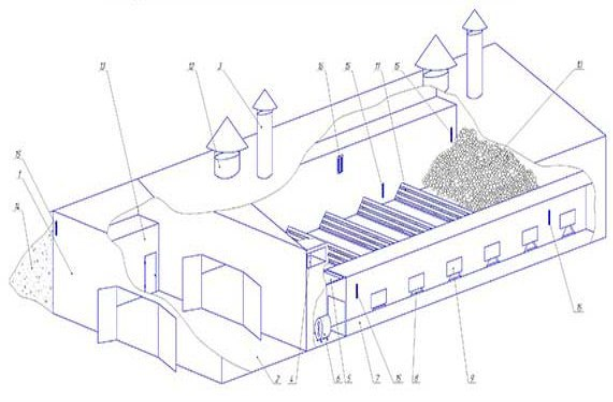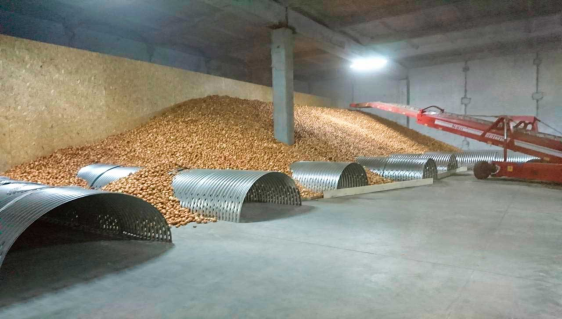Storage is one of the stages of commodity movement from producer to consumer. In the process of storage and transportation of goods from the manufacturer to the final place of sale, regardless of the location and terms of storage and transportation, a certain consumer property of goods is manifested — preservation. The term storage of goods can be viewed from different perspectives. From the point of view of commodity science, storage is a service that ensures the quantitative and qualitative preservation of goods with minimal losses. Storage ensures the sufficiency of food and stability in the supply of food to the population at any time of the year. From the point of view of logistics, storage is considered as a logistic function and a stage in the technological cycle of goods movement from the release of finished products to the consumer or disposal, the purpose of which is to ensure the stability of the initial properties or change them with minimal losses.
Keywords: storage, preservation indicators, losses, elevators, warehouses, trade organizations, pharmaceuticals, humidity, temperature, Ph environment, ventilation.
Storage is carried out by such organizations and enterprises as storages, elevators, warehouses, wholesale depots, refrigeration plants, transport organizations, customs, freight stations, trade organizations, catering establishments, construction firms, and government agencies. At the same time, certain types of activities (storage of grain, grain products, pharmaceuticals, petroleum products and other types of products) are subject to compulsory licensing.
A warehouse is an organization that stores goods as a business. The owner of the goods (mainly a wholesale buyer) enters into an agreement with the warehouse for storage and acceptance of goods, which stipulates measures to ensure the safety of the goods and measures of mutual responsibility. Bonded warehouses are distinguished, first of all, by their closeness and short shelf life; they can also be open type with a storage period of about one year.

Fig. 1. 1-potato storage, 2-room for the bulkhead of potatoes, 3-air duct ventilation, 4-holes for outside air, 5-flat mixing valve blade, 6-axial fan, 7-main channel, 8-triangular hole for conducting the air mixture into the potato mass, 9-gate, 10-potato, 11-triangular wooden box, 12-efficient ventilation duct. 13- automation room for controlling the active ventilation system, 14-embankment, 15-thermometer, 16- psychometer
Warehouses of trade organizations are equipped warehouses of a general marketable type, i.e. for various groups, specialized and universal use. The process of continuous development of economic ties in the field of specialization of activities, cooperation and external integration, as well as the development of interest in logistics.
Storage conditions — a set of external environmental influences caused by the mode of storage and placement of goods in the warehouse.
Storage mode — a set of climatic and sanitary and hygienic requirements that ensure the safety of goods. The climatic and sanitary-hygienic storage regime can be distinguished.
Storage conditions are determined by many factors. The most important are the storage regime, the rules for placing in the storage facility and the sanitary condition of the storage facilities. When accepting products, they check their quality in accordance with the requirements of the standard and the accompanying document. The quality is checked by the organoleptic method, and, if necessary, resort to laboratory tests. It is forbidden to accept: meat without a stigma and goose and mirage (from the incubator) chicken eggs, canned food that does not meet standards in appearance (bomb, crumpled, rusted); without an accompanying document; ungutted poultry; perishable food in the absence of refrigeration equipment.
The following sanitary requirements are imposed on the storage conditions of food products, aimed at maintaining the quality of raw materials:
1) the availability of a sufficient number of storage facilities;
2) compliance with the food storage regime (temperature, humidity, ventilation);
3) observance of storage terms;
4) prohibition of joint storage of raw materials, semi-finished products and finished products;
5) compliance with the rules of commodity neighborhood (in order to avoid the transfer of the smell of products);
6) the presence of special storage equipment (racks, shelves, hooks, subdivisions, chests, bins), which ensures a good preservation of products.
Warehouse equipment: racks (a — overhead, b — cellular prefabricated); shelves; subdivisions; springboard to the scales; brackets with hooks. All warehouses are divided into refrigerated chambers (meat, fish, milk and fat, for fruits and herbs) and uncooled warehouses for dry products, vegetables, bread. Storage temperature — the temperature of the air in the storage. This is one of the most significant indicators of the storage mode. With an increase in temperature, chemical, physicochemical, biochemical and microbiological processes intensify. According to the Van't Hoff rule, the speed of chemical processes increases 2–3 times with an increase in temperature for every 10 degrees. Since the ability of goods to preserve is due to a slowdown in all processes occurring in them, then for most goods, low, close to 0 degrees, storage temperatures are preferable to an increase. There is no single optimal storage temperature for all consumer goods due to the variety of properties that ensure their preservation. In this regard, all consumer goods are classified according to their thermal state and requirements for optimal thermal conditions.
Climatic storage requirements include requirements for temperature, relative humidity, air exchange, gas composition and illumination.
Air exchange is a mode indicator that characterizes the intensity and frequency of air exchange in the environment surrounding goods. In the process of air exchange, a uniform temperature and humidity regime is created, and gaseous substances released by stored goods, containers, equipment and outside air are removed due to air movements in the warehouse — this is circulation.

Fig. 2
The gas composition of air is a mode indicator that characterizes the composition of gases in the environment. The amount of harmful gaseous impurities individually for different storages depends on the degree of outdoor air pollution with industrial waste, as well as exhaust gases, gaseous refrigerants and other substances. When ventilated with outdoor polluted air, they enter the sweet and change the gas composition of the air. In addition, some products during storage emit gaseous substances (carbon dioxide, ethylene, aromatic substances, volatile acids, etc.), which also affects the gas composition of the air in the warehouse.
Illumination is an indicator of the storage mode, characterized by the light intensity in the warehouse. Light, especially sunlight, has a negative effect on the shelf life of most goods, so it is recommended to store most consumer goods in the dark, and if this is not possible, then avoid direct sunlight.
When storing food, quantitative and qualitative losses inevitably occur. Quantitative losses should not exceed the rate of natural loss. The reason for the natural loss during storage may be the ongoing biochemical processes in the product, primarily respiration. Breathing is characteristic for grains, fruits, vegetables, breathing is partly characteristic of flour.
Quality losses limit shelf life, so the product must be sold or used before these losses become noticeable.
In practice, there are two incorrect points of view on the possibility of losses. The first of them excludes the possibility of losses. This is not true, since food is a biologically active material in which physiological processes associated with the consumption of nutrients take place. The second point of view allows for the possibility of a significant level of losses. This is a more dangerous point of view — losses must be prevented by creating special conditions for storing food.
The seller of goods must create the necessary conditions for sale so that the quality of the goods sold is not disturbed. This is of particular importance when storing and selling perishable food products.
The expiration date is the period that is assigned by the manufacturer and after which the food product is unsafe for human health is considered unsuitable for its intended use. The manufacturer of the products sets the expiration date for these goods, indicating the storage conditions. By designating these labeling data on the package, the manufacturer guarantees that, subject to the recommended storage conditions, the food product until the end of this period will meet the safety requirements for human life and health.
Table 1
Effects on the storage of fruits and vegetables
|
№ |
Vegetables and fruits |
o t , о С |
Humidity , % |
Shelf life |
|
1. |
Apple |
-1…+4 |
90–95 |
1–8 months |
|
2. |
Pear |
-1…+3 |
90–95 |
1–6 months |
|
3. |
Carrot |
0…+1 |
95–100 |
4–8 months |
|
4. |
Potato |
+4…+5 |
90–95 |
4–8 months |
Shelf life — is established for cases when information about the expiration date is not provided. Expiration of the shelf life does not mean that the product is unfit for its intended use. This must be confirmed by an expert.
The term of sale is the period during which the product can be offered to the consumer. It is most important for trading organizations. The implementation period is set by the manufacturer, taking into account a certain period of its storage and use for its intended purpose at home.
References:
- Bazarova V. I. and others, Research of Food Products. — M.: Economics, 2006.
- Borovikova L. A. and others, Commodity Research of Food Products. — M.: Economics, 2007.
- Brovko O. P. and others, Commodity Science of Food Products. — M.: Economics, 2009.
- Varibrus V. I., Zhuk Yu.T., Rusch V. A. Commodity Research of Food Products. — M.: Economics, 2006.
- Goncharova V. I., Goloshchapova G.Ya. Commodity Research of Food Products. — M.: Economics, 2009.
- Gabrielyants M. A., Kozlov A. P. Merchandising of Meat and Fish Products. — M.: Economics, 2006.
- Denisova S. A., Pilipenko T. V. Food Fats. Commodity Directory. — M.: Economics, 2008.
- Korobkina ZV, Strakhova S. A. Commodity Research and Gustatory Expertise Goods. — M.: Kolos S, 2003.
- Kruglyakov T. N., Kruglyakova G. V. Commodity Research of Food Products. — Rostov on Don: Ed. center «March», 2009.
- Kolesnik A. G., Elizarova L. G. Theoretical Foundations of Commodity Science Food Products: Textbook for universities. 3rd ed., Rev. and add. — M.: Economics, 2008.
- Lifits IM. Theory and Practice of Assessing the Competitiveness of Goods and Services. — M.: Yurayt-M, 2001.
- Mikulovich L. S. and others Commodity Research of Food Products. — Minsk: BSEU, 2008.
- Nikolaeva M. A. Consumer Goods Merchandising. — M.: Norma, 2007.
- Nikolaeva M. A. Merchandising of Fruits and Vegetables. — M.: Economics, 2008.







